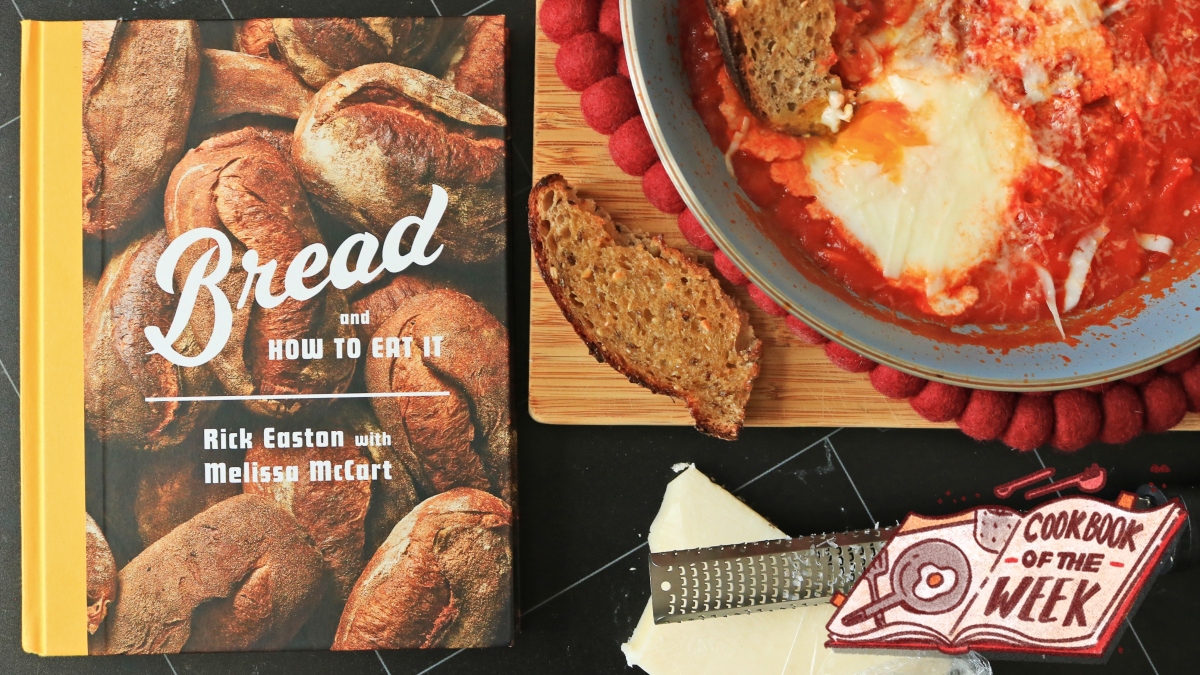
We may earn a commission from links on this page.
Welcome to Cookbook of the Week. This is a series where I highlight cookbooks that are unique, easy to use, or just special to me. While finding a particular recipe online serves a quick purpose, flipping through a truly excellent cookbook has a magic all its own.
If you’ve ever read a post of mine, there’s a high likelihood that it was bread- or carb-related. Maybe it was even focused on the importance of choosing the right bread. Despite the “bad carb” reputation, bread makes the world go ‘round. Maybe you can see where I’m going with this one. The cookbook I chose for this week is Bread and How to Eat It.
I don’t know if it’s normal to have treasured bread memories, but I have them. My favorite one is when I would sit in the kitchen with my mom, the two of us crushing an entire Italian loaf with salted butter while she checked off her Shoprite receipt. That was part of our Saturday morning post-grocery shopping routine. It wasn’t an artisanal sourdough loaf. It wasn’t even pretending to be, frankly. It was the kind of thin-crusted long bread in a papery sleeve sticking out of a basket of clones. My mom was the lady squishing each one and then picking her favorite.
Of course, I do like artisanal breads now and I love making bread at home. I chose this book because even though it has a bit of a mixed message about homemade bread, the chef behind the book is obviously passionate about eating good bread. The second part of the title is actually the most important part.
A bit about the book
Let me say up front: If you’re a home baker or someone who’s interested in learning how to make bread, this is not the book. Easton is pretty ruthless with expressing how he doesn’t think home baking bread is really worth it. (This is not my view.) You’ll find only four recipes for bread, and it’s not super-inspiring for the blossoming bread baker.
However, if you love bread—meaning that bread is part of your daily meals and good luck ripping it from your cold, dead hands—this is your book.
The book’s authors are food journalist Melissa McCart and chef Rick Easton, who runs the much-loved Jersey City bakery, Bread and Salt. Whenever I’m shopping for cookbooks, I walk into a bookstore and browse. In this case, I chose this book, brought it home and then found out Rick Easton was the owner of Bread and Salt—a store whose bread I have deeply enjoyed.
Bread and Salt is located two blocks from where my good friends used to live, and I once went to their home for a “Las Vegas” themed poker night (we love a theme), and we ate a whole pile of tomato-y bread from Bread and Salt. It was crusty and crisp on the outside, chewy on the inside, and not shy with the oil. After remembering this, I was glad I chose this book.
Although Bread and How to Eat It is centered around bread, it’s really more about how bread is a part of meals as a whole. Easton and McCart discuss how, historically, bread has been a way to stretch your ingredients. It’s the ingredient that turns a bowl of soup into a whole meal. Bread is what makes meatballs work. Bread isn’t made for bread’s sake; it’s always best when eaten with something or as a part of a whole. (I adore a hunk of crusty bread but there better be something to put on it.) This book doesn’t teach you how to make bread, but how to use bread from “nose to tail,” as an ingredient.

Credit: Allie Chanthorn Reinmann
The recipes you can expect
Bread and How to Eat is definitely a book of recipes from an Italian/Italian-American lens. The authors describe using bread from “nose to tail” and you can see that in the chapter titles, like Slices, Pieces, Crumbs, and others. The recipes are simple for the most part, with ingredients you can easily find in your grocery store—if not, you can substitute them pretty easily.
This is a book written by a chef who is passionate about the quality of each ingredient, so there are times when the recommendation is a specialty ricotta from Italy, or the highest-quality buffalo mozzarella. Don’t let those things scare you away. I used ground chilis instead of a whole chopped chili in the sandwich recipe I made this week. The closest ingredient substitution that you can come up will likely yield an excellent, enjoyable product.
My favorite part of this collection is that the recipes encourage you to use bread in all stages of its life cycle. I agree with the authors that the prevalence of pre-sliced sandwich bread wrapped in plastic has shifted how bread is incorporated into meals. Basically, that bread is for sandwiches. This book has recipes where leftover bread hunks are the ingredient for a delicious soup, or the recipe requires stale bread—the bread that we so often view as trash.
The dishes I chose this week
I actually made two recipes this week because they were both so simple. Most of the recipes are like that—a few ingredients with a simple method that yields a wonderful dish. They’re exactly the type of recipes I’m always hoping for.
I made the Eggs in Purgatory, and the Broccoli Rabe sandwich recipe. Both of the recipes have around eight ingredients, two of which are salt and olive oil, and they came together in about 10 or 15 minutes. The recipes read like the casual way you’d cook with a friend. Recommendations like “salt to your liking” or “cook it a little on the soft side” gave me freedom to not have to think about technique too much.

Credit: Allie Chanthorn Reinmann
The eggs were luscious in the bright and tangy hand-crushed tomato sauce. The garlic-tinged broccoli rabe and rich ricotta were balanced and satiating. And both of those recipes would have been absolutely lacking if it weren’t for the bread. Easton asks you to griddle up the bread for the Eggs in Purgatory, and the sandwich bread for the rabe recipe must have some of the crumb removed (and saved for another purpose, of course) so you can smear in a healthy dollop of ricotta. Two totally different applications, but the bread is a must in order to make this collection of cooked ingredients into a meal. A simple meal that you’ll whip up and riff off of for years to come.








